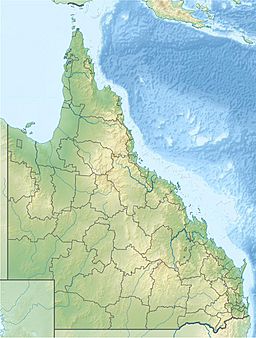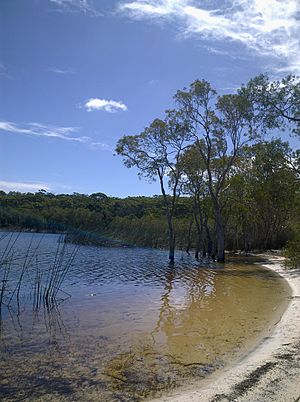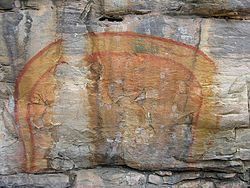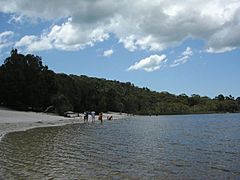Brown Lake (Stradbroke Island) facts for kids
Quick facts for kids Brown Lake |
|
|---|---|
| Bummeria | |
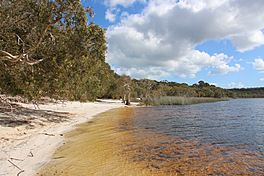 |
|
| Location | North Stradbroke Island, Queensland |
| Coordinates | 27°29′24″S 153°25′57″E / 27.49000°S 153.43250°E |
| Type | Perched |
| Primary inflows | Precipitation |
| Basin countries | Australia |
| Max. length | 1 km (0.62 mi) |
| Settlements | Dunwich, Amity, Point Lookout |
Brown Lake, also known as Bummeria, is a special type of lake called a perched lake. You can find it on North Stradbroke Island in South East Queensland, Australia. This lake is unique because its water is a bit acidic and the soil around it is sandy and doesn't have many nutrients. The area is covered in shrubs and wet heathland plants.
Brown Lake is important for its geography and its amazing natural environment. It shows us how unique landforms, like sand dunes, were created a very long time ago during the Pleistocene epoch. As a perched lake, the way water moves in and out of Brown Lake is quite special and interesting.
The lake is also very important to the Quandamooka people, who are the Aboriginal people of North Stradbroke Island. They have a deep spiritual and physical connection to this place. The local Indigenous people look after the land and share their traditional knowledge about how to manage the environment.
Because Brown Lake has such important cultural heritage and natural value, and because tourism can sometimes cause damage, there's a big effort to protect it. The Queensland Government and the Quandamooka Yoolooburrabee Aboriginal Corporation (QYAC) are working together. They are creating a new plan that uses both traditional Indigenous ways and modern methods to care for the lake.
Contents
What is Brown Lake Like?
Brown Lake is about 1 km long. It's located 4 km east of Dunwich, a small town on North Stradbroke Island. The area has a subtropical climate. This means it has a wet season in winter and a dry season in summer.
The average temperature is "15°–29°C in summer and 9°–20°C in winter." The area gets about 1668 mm of rain each year.
How Brown Lake Formed
Brown Lake sits on a special type of sand dune system. These dunes formed during the ice ages of the Pleistocene epoch. When the sea level was lower, strong winds blew sand from the exposed seabed. This sand piled up to create the dune ridges where Brown Lake now sits.
Perched lakes form in low areas (depressions) in the land. An unusual layer of sand, mixed with old plant material, becomes hard like rock. This hard layer is called 'coffee rock'. It stops rainwater from sinking deeper into the ground. Instead, the water collects above this layer, forming a perched lake.
The sand at Brown Lake is quartz sand. Its yellow-brown color comes from a natural coating on the sand grains. The plants around Brown Lake grow in Podzol soil. This soil is sandy, well-drained, and acidic. It doesn't have many nutrients, partly because of leaching, where water washes nutrients away.
Towns Near Brown Lake
There are three towns located around Brown Lake: Dunwich, Amity, and Point Lookout.
| City | Population |
|---|---|
| Dunwich | 885 |
| Amity | 387 |
| Point Lookout | 713 |
Water Features of Brown Lake
Brown Lake is a perched lake, which means its water has a lot of dissolved organic matter. This makes the water acidic, with a pH level below 6. This organic material also gives the lake its brownish, tea-like color. Lakes with this color are called dystrophic.
Lakes get nutrients from the soil around them. At Brown Lake, the sand and soil have very few nutrients. This means the lake is considered oligotrophic, which describes water bodies with low nutrient levels.
Perched lakes get their water from rainfall. When it rains, the water soaks into the lake. Long periods without rain can lower the water level. However, studies show that Brown Lake's water level has been quite stable. This is partly due to a lot of rain that fell during a big storm in January 1975. Any small changes in water level are likely due to water slowly seeping out of the lakebed.
Animals in Brown Lake
Brown Lake is home to many different aquatic animals. These include small water bugs, fish, and crabs and prawns. These animals are important for conservation because they are rare types of marine life that can live in acidic, humic (tea-colored) water.
Water Bugs
Many types of water bugs live in Brown Lake, such as:
- Acari
- Aeshnidae
- Atyidae
- Baetidae
- Calamoceratidae
- Ceratopogonidae
- Chaoboridae
- Cladocera
- Coenagrionidae
- Copepoda
- Corixidae
- Dugesiidae
- Dytiscidae
- Gerridae
- Gomphidae
- Hydroptilidae
- Leptoceridae
- Lestidae
- Libellulidae
- Limnichidae
- Mesoveliidae
- Nepidae
- Notonectidae
- Orthetrum boumiera
- Chironominae
- Tanypodinae
Fish Species
The fish found in Brown Lake include:
- Gambusia holbrooki (a small fish that is not native to Australia)
- Hypseleotris galii (a native gudgeon)
Crabs and Prawns
One type of crab or prawn found here is:
- Caridina indistincta C1
Plants Around Brown Lake
The plants around Brown Lake are mostly grasses and small plants. This makes the area a coastal wet heathland and shrubland. However, there are also some larger trees.
Some of the plants that grow in this ecosystem are:
- Gahnia sieberiana
- Empodisma minus
- Gleichenia spp.
- Blechnum indicum
- Lepironia articulata
- Baumea spp.
- Juncus spp.
- Eleocharis spp.
How Fish Arrived at Brown Lake
Until about 10 years ago, Brown Lake didn't have any fish. Two fish species, the Gambusia holbrooki and Hypseleotris galii, have since moved into the lake. This happened because of both natural events and human activities.
Natural Ways Fish Arrived
One natural way fish might have arrived is through what Charles Darwin called the 'duck feet theory'. This idea suggests that fish eggs can stick to the feet or mouths of waterbirds. As the birds fly between different lakes, they can accidentally drop these eggs, introducing new species.
Natural water processes also played a role. Big storms and floods can carry fish eggs from one body of water to another. This helps new animals spread to different areas.
Human Activities and Fish Migration
Human activities have also helped fish move into Brown Lake. People using boats on Brown Lake might have accidentally brought fish eggs or even live fish from other lakes on North Stradbroke Island.
In 2014, a large bushfire happened near Brown Lake. A helicopter used the lake to collect water for water bombs to put out the fire. It's thought that this helicopter might have accidentally dropped live fish into Brown Lake from where it last filled up.
Invasive Fish Species
In the 1920s, the Gambusia holbrooki (Eastern mosquitofish) was released into South-East Queensland waters. People thought it would help control mosquito populations. However, later research showed that this fish was no better at eating mosquitoes than native fish. So, it was classified as a pest.
This non-native fish is now affecting the animals in Brown Lake. It competes with native species for food and preys on them. This threatens the natural balance and biodiversity of the lake's ecosystem.
The Role of Lepironia articulata
The Lepironia articulata, also known as grey sedge, is a grass-like plant that grows around lakes. It forms thick patches. Its flower is reddish-brown and shaped like a cylinder. This plant is very important for the Brown Lake ecosystem. Its underwater parts provide a home for the water bugs and fish. Also, when Lepironia articulata decays, it becomes a valuable food source for the lake's animals.
Brown Lake's Aboriginal Significance
Brown Lake (Bummiera) has deep cultural meaning for the Indigenous Quandamooka people of North Stradbroke Island. They have a strong spiritual and physical connection to the lake. They connect with the land through special activities, beliefs, and values that have been passed down through their Law and the Dreaming.
The Quandamooka Yoolooburrabee Aboriginal Corporation (QYAC) says Brown Lake is "one of the most spiritual and sacred places for the Quandamooka People." The Aboriginal people of this area believe Brown Lake is strongly connected to women and children. Only women are allowed to speak for Brown Lake, and they are responsible for caring for the lake and its resources.
Brown Lake is also a place for women-only ceremonies. For example, the Rainbow Serpent, a symbol of water, fertility, and well-being in Aboriginal culture, is believed to live in Brown Lake. As a sign of respect, Quandamooka women would ask permission before entering the lake. If the water had ripples, it meant no entry, but a smooth lake meant women and children could enter freely.
Threats to Brown Lake
Brown Lake is a popular place for visitors. People come here for picnics, barbecues, camping, boating, and swimming. However, too many visitors can harm the lake's ecosystem. Chemicals from urine, soaps, shampoos, and sunscreen can get into the water. This adds too many nutrients, a process called nutrification.
Too many nutrients can cause algal blooms, which are large growths of algae. Algal blooms make the water quality worse and upset the natural balance of the ecosystem. This threatens the animals that live in the water.
North Stradbroke Island has large amounts of valuable minerals like ilmenite, monazite, zircon, and rutile. Because of this, mining often happens near Brown Lake. Mining can harm the environment by destroying animal habitats, causing pollution, and using too much water. This could even lead to lakes drying up if the underground water sources are damaged.
Bushfires and fire management practices, like controlled burning to reduce fuel, also threaten Brown Lake's ecosystem. High temperatures, habitat destruction, and siltation (when soil washes into the water) during fires can greatly affect the plants and animals. Also, bushfires can cause a lot of ash and leaf litter to enter the water. This can increase the biological oxygen demand (BOD) of the water, changing its natural nutrient cycle and harming the plants and animals.
Protecting Brown Lake
Brown Lake is very important for conservation. It has significant cultural and natural value. Protected areas, or buffer zones, are very good at keeping ecosystems healthy. They help protect the variety of life and cultural importance of an area for future generations.
The Queensland Government and the Quandamooka Yoolooburrabee Aboriginal Corporation (QYAC) have included Brown Lake in a plan to expand protected areas. This plan will combine traditional Indigenous ways of managing the land with modern methods. It recognizes the valuable knowledge Indigenous people have about their land and sea.
An example of traditional management is the first planned cultural burn at Brown Lake. In 2020, an all-women team from the Quandamooka Yoolooburrabee Aboriginal Corporation and Queensland Parks and Wildlife Service carried out a cultural burn. This was done to "reduce fuel and aid recovery of culturally significant plant species."
See also


